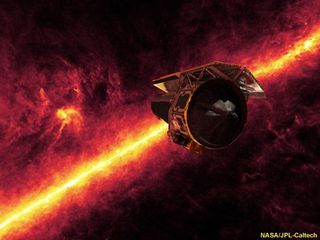Spitzer Space Telescope: A Great First Year

CAPE CANAVERAL -- A year after its launch from Cape Canaveral, the Spitzer Space Telescope is unveiling the invisible: leftovers of stellar explosions, nurseries where stars are born, and the innards of the Milky Way.
"It's hard to convey the mixture of excitement and delight that we have here," said Michael Werner, project scientist for Spitzer at NASA's Jet Propulsion Laboratory in California. "We're exceeding far beyond our wildest dreams."
The $770 million Space Infrared Telescope Facility, later renamed for prominent astronomer Lyman Spitzer, launched last Aug. 25 and entered an orbit around the sun, trailing the Earth. It looks at the infrared part of the spectrum. If a galaxy is cloaked in dust, Spitzer can gaze right through it.
"I think we're on the first of several cycles of discovery and follow up," Werner said. "We've gotten far enough . . . that we can see some areas where there are going to be surprises."
One of those is the early universe. The telescope's ability to see into the past is even better than scientists hoped. The telescope may help them learn about the evolution of galaxies and black holes, especially when its images are compared with those from the Hubble Space Telescope and the Chandra X-Ray Observatory.
"We're starting to look into dark clouds where people had thought there was nothing going on at all," Werner said. For instance, Spitzer may be able to see previously unidentified stages in a star's infancy.
Some of the most promising discoveries are in our own backyard, in the Milky Way.
Get the Space.com Newsletter
Breaking space news, the latest updates on rocket launches, skywatching events and more!
"Spitzer's actually given us a very new perspective on our galaxy," said Ed Churchwell, a Spitzer scientist from the University of Wisconsin in Madison. "We're seeing things, basically, that we couldn't see otherwise."
For example, the telescope sees lots of small dust particles between stars that appear as fine filaments.
"The dust kind of lights up like a neon sign close to hot stars," Churchwell said.
The result: Spitzer can tell tales about how our galaxy is put together.
Churchwell leads one of six Legacy teams, which are funded with the goal of creating a deep database of lasting value. His team is looking at the Milky Way's structure.
Spitzer might be able to tell what our galaxy looks like by peering through it. Does the starry pinwheel have two spiral arms? Four? The special effects common to science fiction can make us forget that we have never snapped a picture of our own galaxy from the outside.
"It's kind of like trying to determine the shape of a forest when you're standing in the middle," Churchwell said.
Spitzer is also able to take multiple images that let scientists see the stars, dust and stellar nurseries inside a galaxy.
"We're very neatly able to dissect galaxies and find their component parts," Werner said.
One example is Spitzer's images of Messier 81, a spiral galaxy that looks different when photographed at different infrared wavelengths. The same is true of other objects.
"Regions of recent star formation light up like Christmas tree bulbs," Werner said. "To me, it's quite remarkable."
Though astronomers have released several pictures and discoveries over the past year, the first big set of scientific papers is coming out in September, as is a large release of public data.
Werner expects the number of requests for telescope time to jump in the wake of Spitzer's initial success.
The telescope is likely to last five or six years, double its minimal lifetime, so there are plenty of discoveries to come. "It's operating absolutely flawlessly," Werner said.
Published under license from FLORIDA TODAY. Copyright © 2004 FLORIDA TODAY. No portion of this material may be reproduced in any way without the written consent of FLORIDA TODAY.
Join our Space Forums to keep talking space on the latest missions, night sky and more! And if you have a news tip, correction or comment, let us know at: community@space.com.

Chris Kridler is a writer, editor, photographer and storm chaser who authored a group of storm-chasing adventure novels called Storm Seekers. As a reporter covering space, her subjects have included space shuttle missions, the Mars Rovers from California’s Jet Propulsion Lab, and a Soyuz launch and mission from Kazakhstan and Russia. Much of that work was published through her longtime column at Florida Today. Her photographs have been featured in magazines and books, including the covers of The Journal of Meteorology, the book Winderful, and the Wallace and Hobbs Atmospheric Science textbook. She has also been featured in Popular Photography. Kridler started chasing tornadoes in 1997, and continues the adventure every spring in Tornado Alley.
Most Popular

